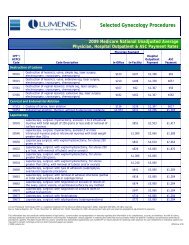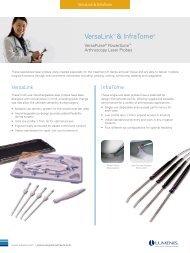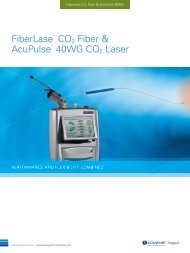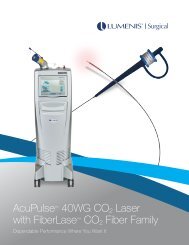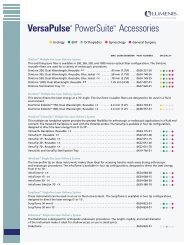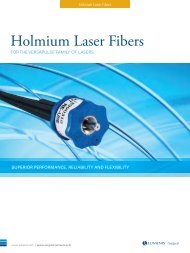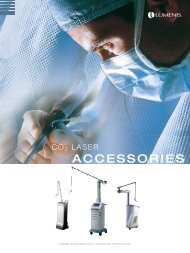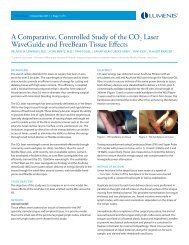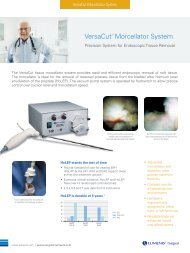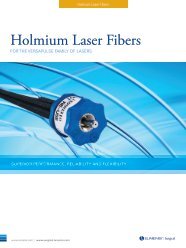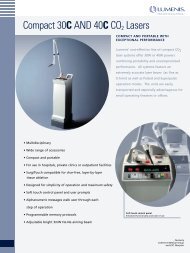HoLAP Technique and Tips - Lumenis Surgical
HoLAP Technique and Tips - Lumenis Surgical
HoLAP Technique and Tips - Lumenis Surgical
You also want an ePaper? Increase the reach of your titles
YUMPU automatically turns print PDFs into web optimized ePapers that Google loves.
AUA 2005 | SAN ANTONIO<br />
LUMENIS BOOTH PRESENTATION<br />
<strong>HoLAP</strong> <strong>Technique</strong> <strong>and</strong> <strong>Tips</strong><br />
Ramsay L. Kuo, MD<br />
Assistant Professor of Urology<br />
Thomas Jefferson University<br />
Medical Collage<br />
Philadelphia, PA<br />
Introduction<br />
The holmium laser is a versatile tool. The 100 Watt high-powered VersaPulse ®<br />
PowerSuite lasers can not only be utilized to fragment urinary calculi of any<br />
composition but also to efficiently ablate, or vaporize, obstructive prostate tissue<br />
with minimal blood loss.<br />
The <strong>HoLAP</strong> technique has a flat learning curve <strong>and</strong> can be incorporated very quickly<br />
into one's surgical practice. <strong>HoLAP</strong> outcomes are similar to those achieved by TURP.<br />
The minimal penetration depth of holmium energy minimizes postoperative irritative<br />
voiding symptoms, while the ability to use normal saline as the irrigant during treatment<br />
virtually eliminates the possibility of dilutional hyponatremia. Long-term follow-up of<br />
<strong>HoLAP</strong> patients over a seven-year period has shown durable improvements in both<br />
maximal urinary flow rates as well as AUA symptoms scores.<br />
Indications<br />
<strong>HoLAP</strong> is offered for the same indications as TURP. In my practice, I use a volume of<br />
60 cc as an upper limit for treatment, with larger gl<strong>and</strong>s treated using the Holmium<br />
Laser Enucleation technique (HoLEP). Gl<strong>and</strong>s larger than 60 cc can be treated with<br />
the <strong>HoLAP</strong> technique; however, more time needs to be allotted for the procedure.<br />
Approximately 1 cc/minute can be treated with the <strong>HoLAP</strong> technique.<br />
Instruments <strong>and</strong> Settings<br />
My st<strong>and</strong>ard setup includes a 26 F resectoscope sheath with laser bridge <strong>and</strong> 30°<br />
lens. I use the 100 Watt VersaPulse PowerSuite holmium laser in conjunction with a<br />
550µ side-firing holmium laser fiber (DuoTome ) as the delivery device. A video<br />
camera <strong>and</strong> monitor is essential.<br />
For the majority of the ablation process, I use settings of 3.2 J <strong>and</strong> 25 Hz. I have<br />
found that higher energy levels allows more efficient tissue vaporization with less<br />
tissue scatter into the endoscopic field. For bleeding points, I change the settings<br />
to 2.5 J <strong>and</strong> 40 Hz.<br />
<strong>Surgical</strong> <strong>Technique</strong><br />
I position the tip of the resectoscope at the bladder neck <strong>and</strong> extend the tip of the<br />
DuoTome fiber until the distal end is seen in the field. I usually begin treatment at 6<br />
o'clock, vaporizing the median lobe tissue at the bladder neck region by rotating the<br />
tip of the fiber over the surface of the prostate. The ablation is deepened to the level<br />
of the surgical capsule, seen by the appearance of well-defined circumferential fibers.<br />
I then proceed distally to ablate the remainder of the median lobe, match the depth<br />
of ablation achieved proximally. Similar maneuvers are utilized to ablate the lateral lobes,<br />
thus creating a widely patent channel. Hemostasis is achieved by defocusing the tip<br />
of the side-firing fiber (moving away from the surface 1-2 mm) over a bleeding point<br />
<strong>and</strong> activating the laser at the aforementioned settings.<br />
Postoperative Care<br />
The vast majority of patients are discharged the day of surgery. If a patient is treated<br />
early in the day <strong>and</strong> does not have a significant history of retention, I will remove the<br />
catheter in the recovery room <strong>and</strong> start the patient on voiding trials. For others, I will<br />
leave the catheter indwelling overnight <strong>and</strong> schedule either home or office removal<br />
the following morning.<br />
Summary<br />
<strong>HoLAP</strong> is an excellent alternative to TURP <strong>and</strong> provides long-term symptomatic relief<br />
with a minimal morbidity profile. Its short <strong>and</strong> flat learning curve makes it an attractive<br />
procedure for urologists to add to their BPH armamentarium.<br />
LUMENIS BOOTH 968



